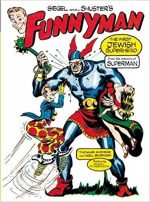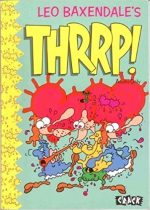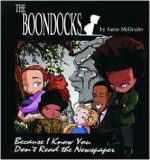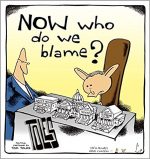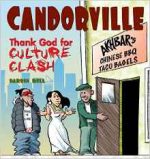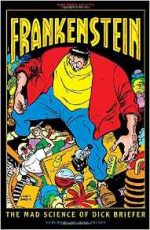
By many & various, edited by Craig Yoe (Fantagraphics Books)
ISBN: 978-1-60699-150-3
After watching far too much news, I dug this book off my shelves. It seemed somehow appropriate…
You’ll hear a lot about the pen being mightier than the sword regarding The Great Anti-War Cartoons, but sadly it’s just not true.
Nothing seems able to stop determined governments, outraged religions and/or rich, greedy – and apparently duly elected, raving mad – bastards from sending the young and idealistic to their mass-produced deaths, especially those innocents still afflicted with the slightest modicum of patriotism or sense of adventure.
Our own currently escalating and deteriorating global situation (but isn’t it always?) proves that mankind is always far too ready to take up arms, and far too reluctant to give peace a chance, especially when a well-oiled publicity machine and vested media interests gang up on the men and women in the street going “yeah, but…â€
We’re all susceptible to the power of a marching beat played on fife and drum…
At least here amongst these 220 plus cartoons and graphic statements we see that rationalism or conscientious objectivity or pacifism or even simple self-interested isolationism are as versed in the art of pictorial seduction as the power and passion of jingoism and war-fever.
All art – and most especially cartooning – has the primitive power to bore deep into the soul, just as James Montgomery Flagg’s iconic Uncle Sam poster “Your Country Needs You†so effectively did to millions of young Americans during the Great War.
How satisfying then to see his is the very first anti-war cartoon in this incredible compilation of images focusing on the impassioned pleas of visual communicators trying to avoid body-counts or at least reduce bloodshed.
The Great Anti-War Cartoons gathers a host of incredibly moving, thought-provoking, terrifying, but – I’m gutted to say, ultimately ineffective – warnings, scoldings and pleas which may have moved millions of people, but never stopped or even gave pause to one single conflict…
Editor Craig Yeo divides these potently unforgettable images into a broad variety of categories and I should make it clear that not all the reasons for their creation are necessarily pacifistic: some of the most evocative renderings here are from creators who didn’t think War was Bad per se, but rather felt that the specific clash in question was none of their homeland’s business.
However with such chapters as Planet War, Man’s Inhumanity to Man, The Gods of War, Profiteers, Recruitment and Conscription, The Brass, The Grunts, Weapons of War, The Battle Rages On, The Long March, Famine, The Anthems of War, The Horrors of War, The Suffering, The Families and Children of War, The Aftermath, Victory Celebration, Medals, Disarmament, Resistance and Peace we witness immensely talented people of varying beliefs responding on their own unique terms to organised slaughter, and for every tut-tut of the Stay-at-Homers there are a dozen from genuinely desperate and appalled artists who just wanted the horror to end.
With incisive examinations of shared symbology and recurring themes, these monochrome penmen have utilised their brains and talents in urgent strivings to win their point (there is also a fascinating section highlighting the impact and energy of the Colors of War) but the most intriguing aspect of this superb collection is the sheer renown and worth of the contributors.
Among the 119 artists include (120 if you count Syd Hoff and his nom-de-plume “Redfield†as two separate artists) are Sir John Tenniel, Caran d’Ache, Bruce Bairnsfather, Herbert Block, Pieter Bruegel the Elder, Ron Cobb, “Ding†Darling, Billy DeBeck, Jerry Robinson, Albrecht Dürer, Art Spiegelman, Robert Crumb, Rube Goldberg, Honore Daumier, Goya, George Grosz, Bill Mauldin, Gerald Scarfe, Ralph Steadman, Thomas Nast and most especially the incredibly driven Winsor McCay.
I’ve scandalously assumed that many of the older European draughtsmen won’t be that well known, despite their works being some of the most harrowing, and their efforts – although perhaps wasted on people willing to listen to reason anyway – are cruel and beautiful enough to make old cynics like me believe that this time, this time, somebody in power will actually do something to stop the madness.
A harsh, evocative and painfully lovely book: seek it out in the hope that perhaps one day Peace will be the Final Solution.
The time has never been more right for cynics like me to be proved wrong…
The Great Anti-War Cartoons and the digitally remastered public domain material are © 2009 Gussoni-Yoe Studio, Inc. All rights reserved.


